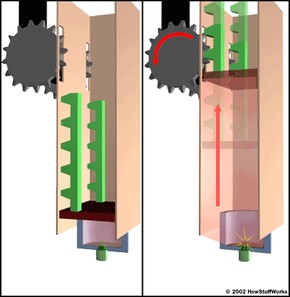Seat Belt Tensioners, also known as pretensioners, are a crucial component of modern vehicle safety systems. Their primary function is to eliminate slack in the seat belt webbing at the onset of a collision, securing the occupant more firmly in their seat. While standard seat belt retractors prevent further extension of the belt during a crash, tensioners go a step further by actively pulling the seat belt tighter. This proactive tightening helps position the occupant optimally against the seat, maximizing the effectiveness of other safety features like airbags. It’s important to note that tensioners are designed to work in conjunction with, not as a replacement for, conventional seat belt locking mechanisms.
 Animation showing how a pyrotechnic seat belt tensioner is activated. A spark ignites gas, creating pressure that moves a piston and rotates the retractor spool, tightening the seat belt.
Animation showing how a pyrotechnic seat belt tensioner is activated. A spark ignites gas, creating pressure that moves a piston and rotates the retractor spool, tightening the seat belt.
Various types of seat belt pretensioner systems are employed in vehicles today. Some systems are engineered to retract the entire retractor mechanism, while others focus on rotating the spool that winds the seat belt. Typically, seat belt tensioners are integrated into the vehicle’s central control system, which also manages the deployment of airbags. This central processor is connected to motion sensors that are sensitive to sudden deceleration, a key indicator of an impact. When a collision is detected through these sensors, the processor triggers the seat belt tensioners, followed by the airbags, in a coordinated safety response.
While some pretensioner designs utilize electric motors or solenoids, pyrotechnic pretensioners have become increasingly prevalent due to their rapid activation speed and reliability. A typical pyrotechnic pretensioner, as illustrated in the diagram, operates using a small controlled explosion.
At the heart of this system is a chamber filled with a combustible gas. Within this chamber, a smaller compartment holds an explosive igniter material. This igniter is connected to the central processor via two electrodes.
Upon detecting a collision, the vehicle’s processor sends an electrical current to the electrodes. This current generates a spark, igniting the igniter material. The combustion of the igniter then rapidly ignites the gas in the main chamber. The resulting combustion produces a surge of pressure that forcefully drives a piston situated within the chamber upwards.
Attached to the piston is a rack gear. As the piston rapidly ascends, this rack gear engages with a gear that is connected to the retractor spool mechanism. The high-speed movement of the rack gear causes the spool to rotate forcefully, effectively winding up any slack in the seat belt webbing and ensuring the occupant is securely restrained.